Forum Replies Created
-
AuthorPosts
-
CCWBRA Secretary
KeymasterHi Hotav8r49!
I apologize but it seems our Classifieds page is down. I have IT working on that. If you want to send me pics, price, description and your contact info to Secretary@ccwbra.com I will get it posted for you and it will be displayed once the error has been corrected.
CCWBRA Secretary
KeymasterYes it is!
See the attached flyer on the details of what is included and the price breakdown.
CCWBRA Secretary
KeymasterHere is the official 2019 Skuas on the Lehigh post with race results and pictures! Check out the blog post to find out more about a FIRST EVER occurrence at a CCWBRA event!
Thank you to the Race Directors, Fred Allerton and Tom Kerr for putting on another great event!
https://ccwbra.com/2019/06/21/skuas-on-the-lehigh-2019/
CCWBRA Secretary
KeymasterLooks Great Spencer!
Sending out the boat registration and decals today!
CCWBRA Secretary
KeymasterSouthern Comfort is the nickname for the Southern Region which is Texas, Arizona, New Mexico, Oklahoma, Kansas area.
The “Appalachian Region” nicknamed Moonshiners for now is West Virginia, Kentucky, Tennessee, Louisiana, Arkansas, Mississippi, and Alabama. You would like am updated Regional designation and keep Moonshiners or do you want a new nickname? We could call it Appalachian to the Gulf Region since it has grown so big.
Eight Regions so far:
Southeast Region (FL,GA) – RUMRUNNERS
Carolina Region (NC,SC) – *Need a nickname still*
MidAtlantic Region (DE, MD, NJ, VA, PA) – *Need a nickname still*
Northeast Region (ME, VT, NH, NY, CT, MA, RI) – *Need a nickname still*
Pacific Region (OR, WA, UT, NE, CA, ID) – *Need a nickname still*
Southern Region (TX, KS, OK, NM, AZ) – SOUTHERN COMFORT
Midwest Region (MN, MI, MO, MT, WI, CO, IL, IN, IA, ND, SD) – BOOTLEGGERS
Appalachian Region (TN, WV, KY, AL, AR, LA, MS) – MOONSHINERS
Let me know if you have any other ideas!
-
This reply was modified 5 years, 1 month ago by
CCWBRA Secretary.
CCWBRA Secretary
KeymasterThere’s a great Blues Festival in downtown Allentown Sat June 9, day of race, 12 noon to 10:00pm. 6 stages of FREE Blues music. Samantha Fish Band is the headliner! Many other great Blues bands, too.
Leave the boat trailer on Adams Is. after the race and go back for it! Check out the link for more info:http://www.downtownallentown.com/events/blues-brews-and-barbecue
-
This reply was modified 5 years, 11 months ago by
CCWBRA Secretary.
-
This reply was modified 5 years, 11 months ago by
CCWBRA Secretary.
June 2, 2018 at 8:05 pm in reply to: One week left to register for Urbanna Cup! Early Reg. closes 5/15! #10209CCWBRA Secretary
KeymasterCheck out the race results for 2018 Urbanna Cup here:
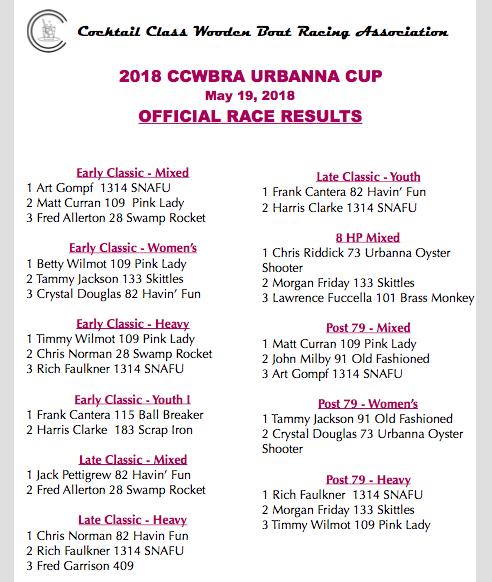
CCWBRA Secretary
KeymasterChris Norman: Thanks for all of the replays. I’ll see you in Virginia.
CCWBRA Secretary
KeymasterFred Allerton:
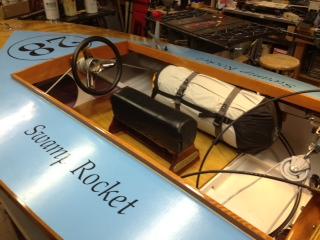
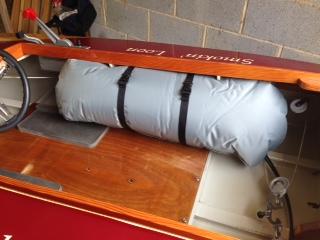
CCWBRA Secretary
KeymasterLee Edmonds: Since CLC CCRs have built-in floatation, I’m guessing you are building from CCWBRA plans. Also, since you’ve signed up for Urbanna, you probably want to get the floatation installed yesterday. The floatation bags and balls that Kim mentioned, effectively tied in, work very nicely. Tie-in straps can be simple or complex, whatever works for you and that you can convince a race inspector that they will hold the bags in place in the event of a flip.
Without going into all the pros & cons of foam floatation vs. air tanks, I’ve opted to seal off Frame 2 (using no foam), and use a 4″ inspection port for ventilation when out of the water. Not difficult. Doesn’t weigh much. Works. Our next CCR will have more floatation aft. But that’s another story. See you in Urbanna, Lee
Fred Allerton: As Kim and Lee say, a few CCR boats have Optimist floatation bags stuffed under both side decks. They are available in 48L and 43L capacity. Boats #28 and #53 have steering cables routed under the decks, which reduces some of the available space for the length of the Opti bags, so the shorter 43 liter bags are stuffed into compression sacks to help fit the bags in between cable returns. If your cable is on top of the coaming as most are, then you shouldn’t have that problem. The bags are buckled-in under both side decks with straps. You have to tie them down good – otherwise they take right off with all the helium. Oops- I mean air! Annapolis Performance Sailing is another source for bags. OptiParts for full product line information: http://www.optiparts.com/products/ airbags.asp Fred #28
CCWBRA Secretary
Keymaster
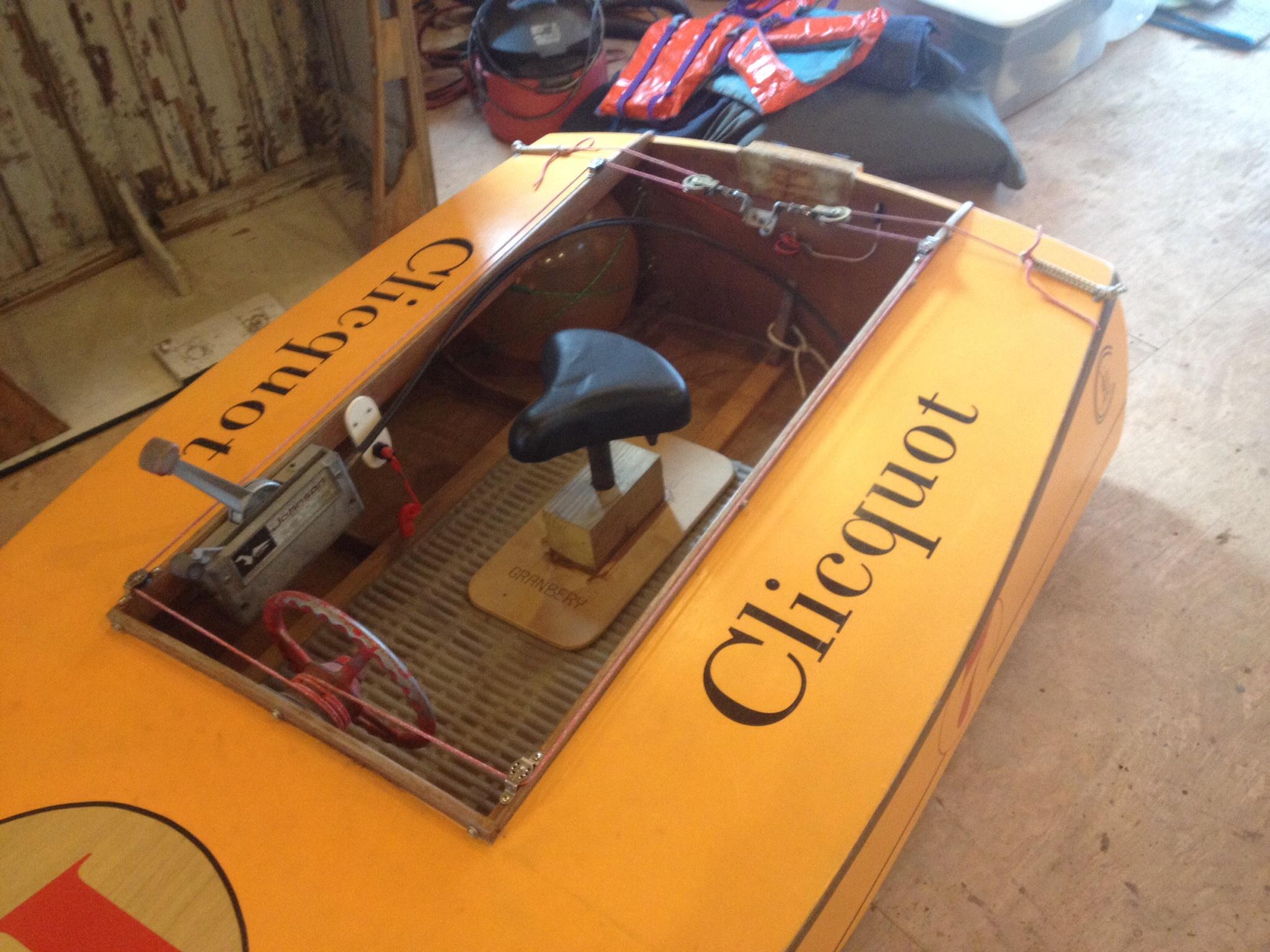
CCWBRA Secretary
KeymasterLee Edmonds: Hi Stephen, I was the worst offender at KIYC Saturday, smacking a Glue Factory CCR in one of the hairpin turns and washing out its kill switch connector with the wall of water I sprayed into Mike’s boat. That’s doubly bad because I’m the one at the Drivers’ Meeting that was talking about being nice in turns. So it’s painfully obvious to me that I need more training, or practice, or both!
As the Protest Committee was completing their last task of the day and everyone was being hurried into the Club for the awards ceremony, Tara and Tom were talking about having a five-minute discussion (I’ll need more than just five minutes of remedial training) during future Drivers’ Meetings talking specifically about the rules of the lanes in turns. They talked about including graphics and diagrams to help explain the rules. I think this is a wonderful idea and am hoping for others to support such a training session. There are other drivers with lots of practical and technical expertise in rounding marks that could contribute to the development and evolution of such a training tool.
I am sure that the basics, explained clearly by drivers that know the rules, will help the rest of us better understand our responsibilities in turns. But I’m also fairly certain that common sense is something we all need to exercise while racing. Well, I certainly know I do.
Thanks for bringing up this topic. Lee
Tom Kerr: I’m glad Steve has brought this topic out into the sunlight. As often is the case, it takes an unhappy experience to get this to happen. As Tara (the one with the experience in such matters) and I (the one who is safer in a canoe) talked about this, we realized that this is a teachable moment for all of us. The association needs to nail down some guidelines, and each of needs to learn about how fair and safe driving rules and competitive strategy fit appropriately into a race. I, for one, have been confused about that, and I’m going to guess that the handful of new drivers on Saturday knew even less, unless they have raced in other venues. From the safety side, this feels like a critically important topic.
Kim Granbery: Steve, my currently non-official take as an original attempter to create a brief, simple set of rules to keep everybody safe while not stifling spirited competition was based primarily on the Rules as defined by US Sailing.
CCWBRAs original rules were based more on not who is right, but who is wrong.
Rule #1. Overtaking boat keeps clear….if you are looking at the back of some bodies helmet: you are most likely the overtaking boat. You are the BURDENED vessel.
Rule #2 Outside boat on the corner keeps clear… if somebody else is between you and the mark: you are the outside boat and thus the BURDENED vessel.
From my personal experience; I don’t always know when I’m right, and that’s a good reason to yield right of way. And 95% of the time I know when I’m wrong and that’s a good reason to yield right of way.
So when in doubt, yield right of way.
I’ve seen our winningest drivers do it on a regular basis and still take home the big one. Have fun and get a good start, if you do the guy in front of you is over early and won’t be on the podium.Ian Millington: I think this is one of the most important and yet least addressed issues in the league. I know we’re all competitive drivers and I respect that fact. It wouldn’t be called racing if we were not. The problem is that some people seem to have a better grasp on corner entry and exit better than others. The boats we race have a very fine line between control and cavitation. I know that I’ve been agressive on both ends but I make sure to back out of the throttle and yield to any boat in front of me in order to avoid contact and abide by league rules. I think the CCWBRA should hold a demo class for all new and current members in order to establish a base line. Potentially the best fix is, as drivers, we all need to be certified at some point through out the year in order to compete? So far the most stringent rules we have involve 1/4″ worth of transom height, yet anybody can hop in a legal boat and race. When these new drivers enter the boat they have but merely the rules and a vague understanding given from a drivers’ meeting. The drivers’ meeting consist of a basic and swift recap of rules and operations. Nothing close to what novice drivers need to know in order to be safe and efficient in competition.
Possibly the best way to combat this issue is to mandate a certification class. It doesn’t need to be an incredibly lengthy class such as the USCG mandates but something that at least addresses all of our main racing concerns. One should obviously know the rules of the road (water) but maybe we need to address what proper boat lengths are in a true driving situation. It’s one thing to say 16′ and it’s another to run it in a real life situation. I understand that senior drivers probably have a better grasp but I think that all drivers need to be on the same par. Being able to drive a boat is one thing, to efficiently race it is another. That’s why I feel we need a proper drivers “license” and not just a race legal boat. I’m open to any criticism
Kim Granbery: Ian, I think you have an excellent point, well stated. We have numerous committees to tackle numerous problems and just like we have a new Juniors committee I think we could benefit from an Education, Training and Certification Program. I think your idea is worth bringing up at the meeting at the Nationals.
CCWBRA Secretary
KeymasterFred Allerton: Here are some photos



CCWBRA Secretary
KeymasterFred Allerton: Helmets – Standards and colors
The selection of helmet style is ultimately the individual’s responsibility as long as it meets either the recommended or permitted standards stated in the Racing and Safety Handbook.
The recommended helmet style is full-cut open-face, and DOT certified or Snell certified. If you’re searching for a new orange helmet at a reasonable price an example to check out is Z1R Jimmy Retro Helmet: http://www.z1rhelmets.com/products/?productGroupId=2344
If you’ve already got a suitable helmet and you’re painting it to meet the 2013 standards, be careful to use paint that’s compatible with your helmet material. Chlorinated solvents have been known to react with some helmet materials, such as ABS, and cause brittleness.
I experimented with painting two helmets. After checking with RUST-OLEUM Customer Support about the compatibility w/ ABS, I used RUST-OLEUM “Painters Touch Ultra Cover” 249088 “Gray Primer” and RUST-OLEUM “Painters Touch Ultra Cover” 249095 “Real Orange” Finish Coat (12 oz spray cans), with good results.
The well-used Bell motorcycle helmet with the new orange paint (in the second photo) will stay retired because of its age and condition, but otherwise it would fit into the recommended helmet style category.
Bell “Faction” is one of the ABS bike/skateboard helmets popular in the 2012 CCWBRA racing circuit (see third photo – before and after). This style of helmet falls into the “permitted” category of the new Safety Standards, but not the “recommended” category. Before painting I just masked off the vents and edges and scuffed the ABS shell with a 3M pad. Then I lightly sanded the primer before finish coating with orange.
CCWBRA Secretary
KeymasterMarty Calon: We got back to work the weekend before last, only to find out that the pump for one of the epoxy components was broken. That was the end of that work session until Jack got a replacement from CLC in Annapolis. CLC sells the epoxy pumps (the pair) as a separate item, so no worries there.
This past weekend, we resumed working on the fiberglass bottoms in the tanks and under-floor sections, tedious, messy, and fortunately will be completely covered. To do a neater job would require spending at least twice as much time on areas that will be completely or mostly hidden, and we’re not making fast progress as it is due to the usual scheduling and weather conflicts.
The temperature inside the garage, even with the door open, was in the mid-90s. I had been worried that this might be too warm to allow good working time for the epoxy, but with small batches and fast and sloppy application, and four hands working on it, it was not a problem. We got at least 15-20 minutes from each batch, and we didn’t waste any of the precious stuff. Overheating of and dripping sweat from the boatbuilders was a bigger concern!
This friday, forecast for sunny and 80 degrees, we’ll continue with the same task.
Here are before and after shots of the joint at bulkhead 3. I spent some time grinding and sanding it down so it would be flush, as pushing it down any farther would have required more muscle and weight than we could muster. This is the part that pulls the bow up into place, so there’s a lot of tension on it. The instruction manual shows the same slight misalignment, so we’re in good company.
Before:
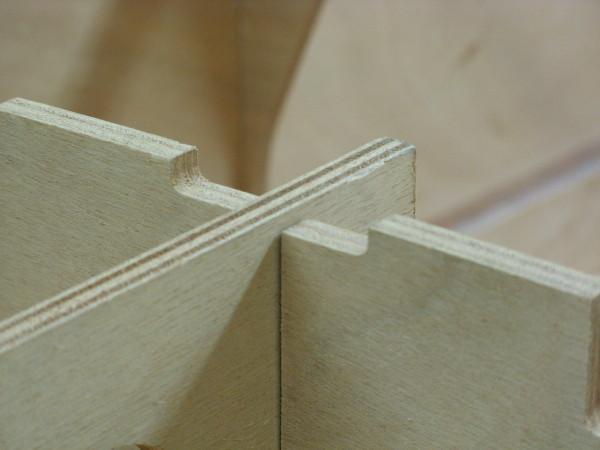
After:
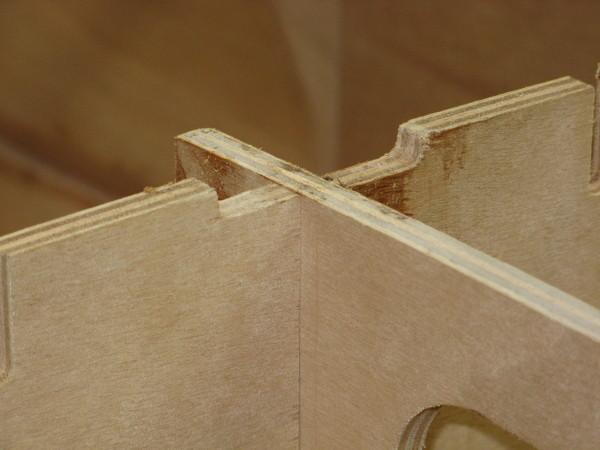
Here is a photo of a “before” narrow epoxy fillet, which will be revised with more epoxy:
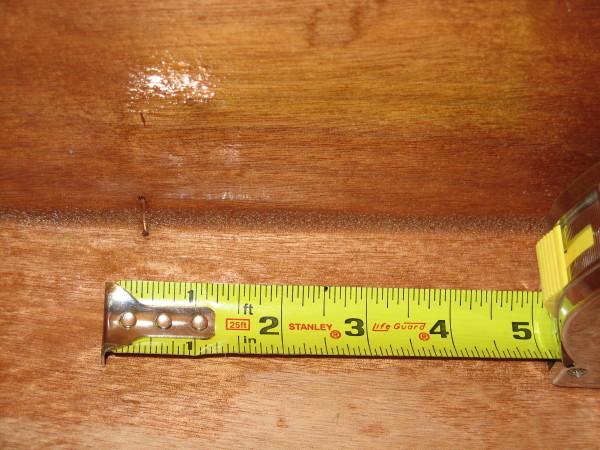
Here is a photo of one of last weekend’s fillets, much thicker:
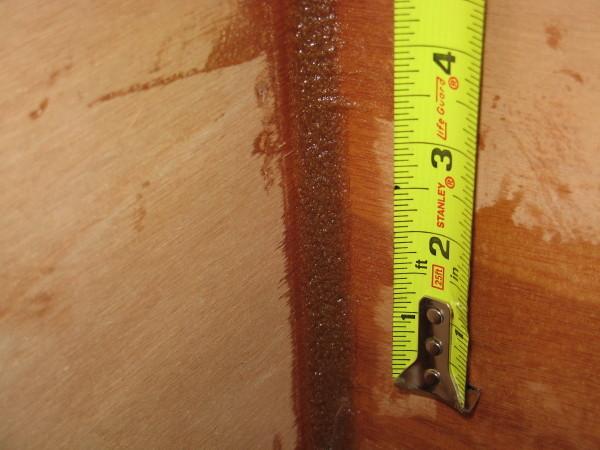
-
This reply was modified 5 years, 1 month ago by
-
AuthorPosts
